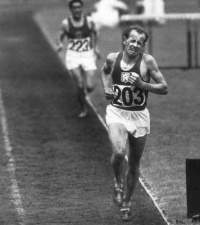Considered one of the great athletic figures of the 20th century .

Biographical synthesis
He was born in Kopřivnice, Czechoslovakia on September 19 , 1922 . Four times Olympic champion, he has the honor of having achieved three gold medals (5,000 and 10,000 meters and marathon) in the same 1952 Helsinki Olympic Games , a feat that was not surpassed until the Atlanta 96 Olympics. He participated in the Second War. At the end of the World Cup , Zatopek joined the army to pursue a military career, and reached the rank of colonel.
Beginnings in sport
Zatopek’s impressive career began purely anecdotal, when he worked at the Bata shoe factories, a company that sponsored a race each year in which the people were little less than forced to compete. Dragged to the starting line, he had no choice but to run and, to his surprise, he finished second, prompting him to participate in other races. He created his own training system, which consisted of doing short distances, which allowed him to gradually increase his speed.
Sports race

It was unveiled in athletics International Tournament Championship Europe of 1946 , held in Oslo , where he was fifth in the 5,000 meters. Two years later came the London Olympic Games , in which he won the gold medal in 10,000 meters with a new Olympic record (29 minutes, 59 seconds and 6 hundredths) that stunned the stadium public, and took silver in the 5,000 meters. In the four years prior to the Helsinki 52 Games, he broke the 10,000-meter world record five times, once the ten-mile, two the twenty-kilometer, and another two the hour and once the thirty kilometres.
In this second Olympic event, the Czech official again became the only winner of the 10,000 and 5,000 meters tests with world records (29 min, 17 sec, 0 cent and 14 min, 06 sec and 6 cent), which that equaled the prowess of the Finn Hannes Kolehmainen; He also won the marathon, a test he was running for the first time, with a new Olympic record (2 hours, 23 min and 03 sec). To top off the glory of these Olympics, his wife, javelin thrower Dana Zatopkova, added a fourth gold medal to the marriage collection .
He returned to the tracks in Melbourne again in 1956 , but age and injuries harvested from so many years of hard work held him back against Algerian Alain Mimoun, who won the test with a formidable career that earned him the respect of the public and of the former champion who took off his cap to greet him from sixth place in the standings. Two years later, in 1958 , he said goodbye to athletics on the tracks of Guipúzcoa, Spain at the Lasarte International Cross, with a brilliant sporting record that included, in addition to the aforementioned titles, eighteen world records in nine athletic specialties , beaten between 1947 and 1950 .
In 1997 , when he was seventy-five years old, he was named “Best Athlete of the Century” during the international meeting held by the athletics association “La Zapatilla de Oro”.
His last years
In his later years he worked as a Physical Education teacher and held his post in the army of the Czech Republic .
Death
He died in Prague on November 22 , 2000 as a result of a stroke.
